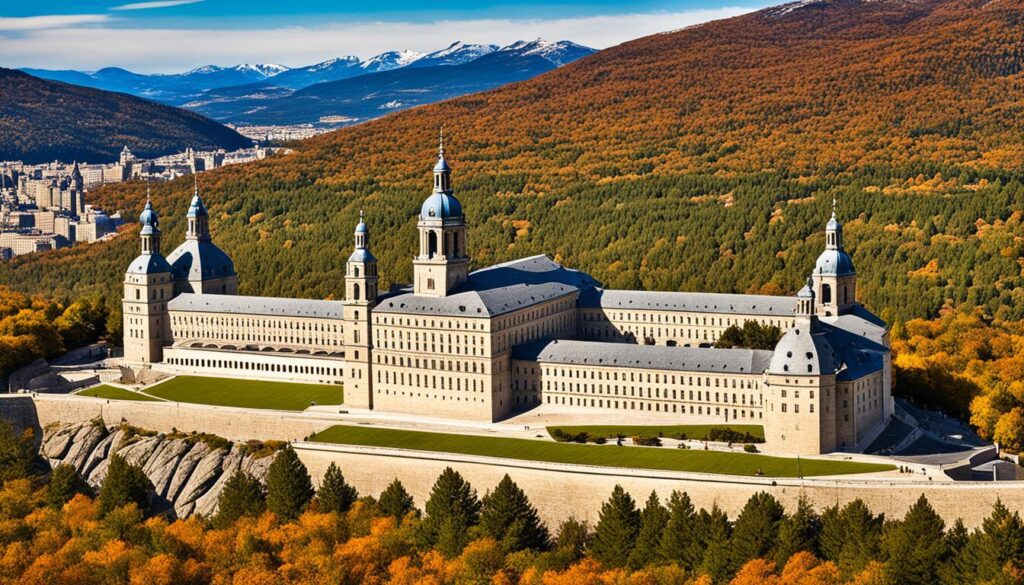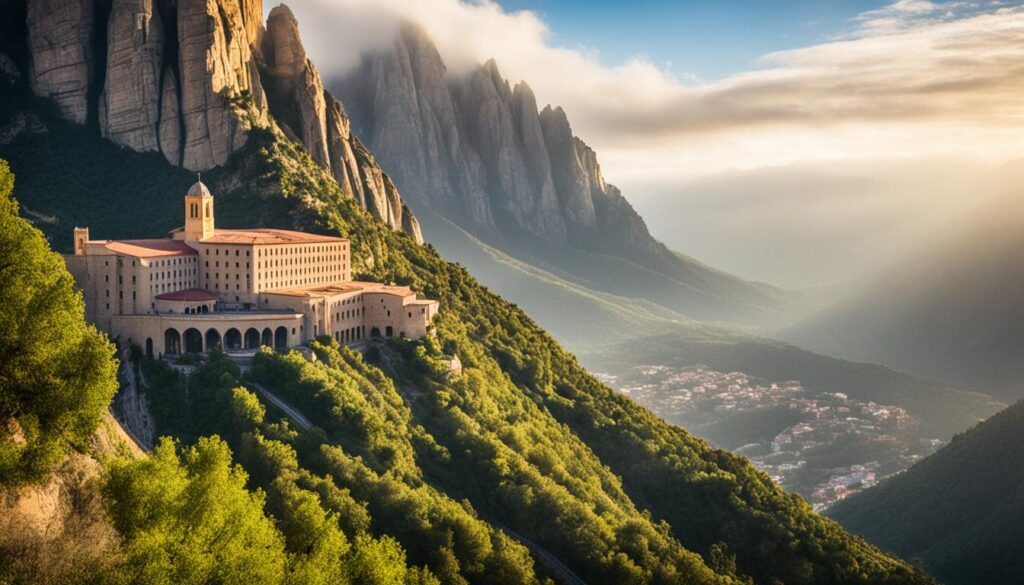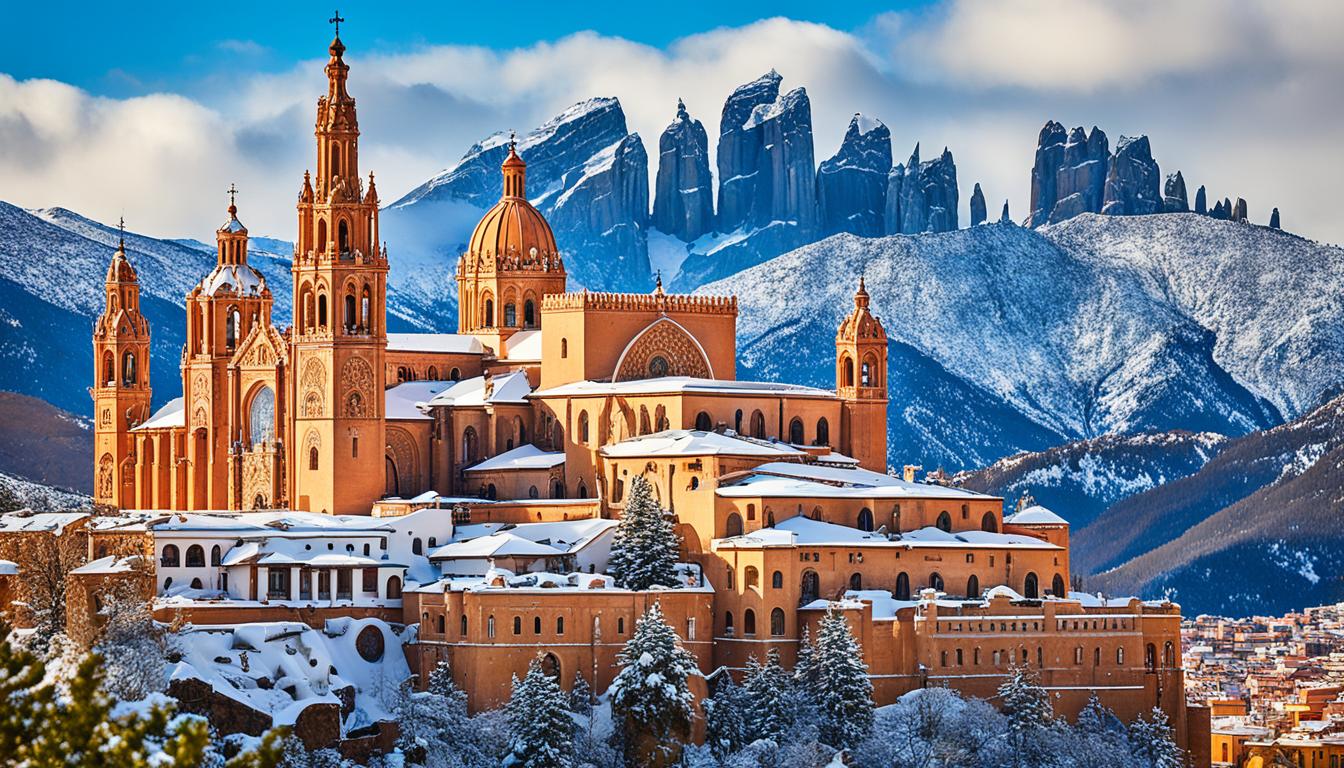Spain is full of historical landmarks that show off its rich culture. You’ll find ancient Roman ruins and grand medieval cathedrals. These sites highlight Spain’s amazing architecture and art from the past. If you love history or want to dive into Spain’s legacy, this guide is perfect for you.
Spain has 45 UNESCO World Heritage sites, making it third in the world for these sites. This shows how much history and culture Spain has. From the Alhambra in Granada to the Seville Cathedral, these places prove Spain’s lasting legacy and its people’s creativity.
Key Takeaways
- Spain is home to a wealth of iconic historical landmarks that showcase the country’s rich cultural heritage.
- The country ranks third globally in the number of UNESCO World Heritage sites, with 45 such designations.
- These landmarks range from ancient Roman ruins to grand medieval cathedrals, offering a captivating glimpse into Spain’s layered past.
- Exploring these historical gems can provide a deeper understanding and appreciation of Spain’s remarkable architectural and artistic achievements.
- Whether you’re a history enthusiast or simply seeking to immerse yourself in the country’s captivating legacy, this guide will inspire you to embark on a journey through Spain’s most remarkable historic landmarks.
The Awe-Inspiring Legacy of Spain’s Historic Sites
Spain is full of historical landmarks that show off its rich culture. You can see ancient Roman ruins and grand buildings that have lasted for centuries. These sites highlight Spain’s past engineering and art skills.
From Ancient Ruins to Architectural Wonders
The Roman Bridge of Cordoba is a key example of Spain’s historic architecture. Built in the 1st century BC, it crosses the Guadalquivir River. It shows the amazing skills of the Roman Empire.
The Alhambra in Granada is another highlight. It mixes Moorish and Christian styles. Its beautiful palaces, gardens, and walls tell the story of Spain’s Muslim past.
Immerse Yourself in Spain’s Rich Cultural Heritage
Visiting Spain’s landmarks lets you dive into its deep culture. The Seville Cathedral is a Gothic wonder and where Christopher Columbus is buried. The Santa Eulalia Basilica in Merida shows Roman, Visigothic, and Christian history.
Walking through medieval Toledo or the Montserrat Monastery in Catalonia feels like stepping back in time. These places show the long history and traditions of Spain.
Exploring Spain’s landmarks, ruins, and famous buildings helps visitors understand and value its culture. Sites like these connect us to Spain’s history, inviting us to experience its amazing past.
Cordoba’s Iconic Roman Bridge: A Testament to Engineering Ingenuity
In the heart of Spain’s Andalusian region, Cordoba is full of historical wonders. The Roman Bridge is one of its most impressive sights. Built in the early 1st century BC, it crosses the Guadalquivir River, connecting the old and new parts of the city.
The Roman Bridge of Cordoba shows off the Roman Empire’s engineering skills. It has 16 arches made of local stone. For over two thousand years, it has stood strong, thanks to many restorations. In the 12th century, Arab geographer Muhammad al-Idrisi called it the most beautiful and solid bridge he’d seen.
For centuries, the Cordoba Roman Bridge has been key to the city’s growth. It was important during battles in the 14th century and is now a popular spot for both locals and tourists. Today, this well-kept cordoba roman bridge amazes people with its beauty and link to Spain’s ancient ruins spain and roman architecture spain.
“The Roman Bridge of Córdoba surpasses all other bridges in beauty and solidity.” – Muhammad al-Idrisi, 12th century Arab geographer
The Roman Bridge in Cordoba is a symbol of the Roman Empire’s engineering skill. It still draws visitors, showing off Spain’s rich roman architecture spain and ancient ruins spain. Walking across it, you’re amazed by the construction feats that have lasted for centuries.
The Alhambra: A Mesmerizing Blend of Moorish and Christian Architecture
In the heart of Granada, Spain, the Alhambra is a stunning mix of Moorish and Christian styles. It started in the 9th century and became a royal palace, mosque, bath, and garden complex. The Nasrid dynasty made it even more beautiful in the 13th century.
Explore the Stunning Palaces and Gardens
At the Alhambra, you can see the Palacio Nazaríes’ beauty. It has amazing tilework, arches, and courtyards that show Moorish style. The 16th-century Palace of Charles V shows Christian influence after the Reconquista.
The Generalife gardens are a peaceful place with greenery and water. They offer a break from the busy palaces.
Witness the Grandeur of Al-Sabika’s Hilltop Wonder
The Alhambra sits high on Al-Sabika hill, looking over Granada. Its red walls and towers stand out against the Sierra Nevada mountains. This place has been a UNESCO World Heritage site since 1984.
It’s a mix of Moorish and Christian styles. Visitors can see the beauty of this hilltop spot. They can enjoy the view and the mix of architectural styles.
“The Alhambra is a jewel in the crown of medieval Islamic Spain and one of the most beautiful and well-preserved examples of Moorish architecture in the world.”
| Architectural Feature | Moorish Influence | Christian Influence |
|---|---|---|
| Palacio Nazaríes | Intricate tilework, ornate arches, elegant courtyards | – |
| Palace of Charles V | – | Renaissance architecture |
| Generalife Gardens | Lush greenery, tranquil water features | – |
| Al-Sabika Hilltop | Striking red walls and towers | – |
Seville Cathedral: Gothic Splendor and the Tomb of Columbus
Seville Cathedral is a stunning example of Spanish Gothic architecture. It was named a UNESCO World Heritage site in 1987. This cathedral is the third-largest church in the world, covering about 11,500 square feet inside. It started in 1402 and got a new central dome after it fell down in 1507.
The Giralda tower is a key feature, standing 343 feet tall. It used to be a minaret from the old mosque on the site. Now, it gives visitors a great view of Seville’s Plaza de España. Inside, there are over 80 chapels along the high central nave.
Seville Cathedral also has the tomb of Christopher Columbus. His remains came here in 1898 from different places, making the cathedral even more important. The orange tree courtyard shows the site’s mix of Moorish and Christian styles.
Visiting Seville Cathedral is a must for anyone interested in Spain’s history or Gothic architecture. With fast-track tickets and best visiting times, you can fully enjoy this UNESCO site.
| Seville Cathedral Facts | Details |
|---|---|
| Size | Third-largest church in the world with 11,500 square feet of interior space |
| Architecture | Largest Gothic cathedral globally, incorporating elements from an earlier mosque |
| Construction | Began in 1402, with reconstruction continuing until 1903 after a dome collapse |
| Tomb of Christopher Columbus | Believed to house the remains of the renowned explorer |
| Giralda Tower | 343-foot tower with a scenic vista of Seville’s Plaza de España |
| Visiting Hours | Monday to Saturday: 10:45am–5pm, Sunday: 2:30–6:30pm |
Seville Cathedral’s size, Gothic details, and history make it a top spot for exploring Spain’s culture. You can enjoy the grand nave, the Giralda tower, or the tomb of Christopher Columbus. This cathedral shows Spain’s lasting architectural and historical beauty.
Santa Eulalia Basilica: A Window into Merida’s Layered History
The Santa Eulalia Basilica in Merida is a key piece of the city’s history. It was built in the 18th century on top of an old Roman church. This church was first dedicated to Saint Eulalia, a young martyr from the Christian persecutions under Emperor Diocletian.
Uncover the Secrets of the Captivating Crypt
Underneath the basilica is a crypt full of secrets. Here, visitors can explore Merida’s history. The crypt has Roman mausoleums, a tomb with beautiful mosaics, and Visigothic tombs with marble. These show how Merida changed from Roman to Christian rule over time.
The Santa Eulalia Basilica connects us to Merida’s deep history. It shows the city’s mix of cultures. From Roman architecture to Visigothic Christianity, the basilica and its crypt let us see Merida’s lasting history.
“The Santa Eulalia Basilica offers a tangible connection to Merida’s rich history and the enduring legacy of its diverse cultural influences.”
| Historical Fact | Significance |
|---|---|
| The current 18th-century church is built upon the remains of an ancient Roman church | Reveals the layered history of the site, with the Roman foundations underlying the present-day basilica |
| The ancient Roman church was dedicated to the martyr Saint Eulalia | Highlights the transition from Roman to Christian religious significance of the site |
| The crypt contains Roman mausoleums, a mosaic-sealed tomb, and Visigothic-era tombs | Showcases the evolution of burial practices and the shift from Roman to Visigothic rule in Merida |
El Escorial: A Monumental Tribute to Spanish Victory
Nestled just outside of Madrid, the El Escorial complex is a key part of Spain’s history. It was built by King Philip II in the 16th century. This massive structure honors Spain’s win over France in the Battle of St. Quentin.
Designed by Juan Bautista de Toledo, El Escorial mixes Spanish architecture with Renaissance style. It took from 1563 to 1584 to build. The complex includes a royal palace, a basilica, a library, and a place for Spanish monarchs.
At El Escorial, you can see stunning Carrara marble statues and paintings by famous Spanish and Flemish artists. The grand buildings show the ambition of the Catholic monarchy in Spanish history.

Walking through El Escorial lets you explore Spain’s culture and architecture. Its design shows the skill of Spanish architects. Over a thousand workers helped build this huge project, showing the Spanish history achievement.
El Escorial shows the power of the Catholic monarchy in Spanish history during the Renaissance. This place still amazes visitors with its beauty and history of el escorial.
historical landmarks in spain: Uncovering the Gems of Spain’s Past
Spain is more than just famous landmarks. It has many hidden historical treasures waiting to be discovered. Places like the Roman walls in Lugo and the ruins of Belchite, destroyed in the Spanish Civil War, show the country’s varied history and architecture.
The La Sagrada Familia in Barcelona is a must-see. It’s a mix of old and new, designed by Antoni Gaudí. Started in 1882, it amazes with its Gothic details and tall spires. Getting in costs about €26 per person.
Spain has more than just famous cathedrals and museums. It has hidden spots that tell the country’s rich cultural story. Places like the peaceful gardens of the Alcázar of Segovia and the beautiful Roman aqueduct show Spain’s long history.
| Historical Site | Location | Ticket Price |
|---|---|---|
| Prado Museum | Madrid | €15 (free admission on certain days) |
| Guggenheim Museum | Bilbao | €16 |
| Reina Sofia Museum | Madrid | Varies |
| Teide National Park | Tenerife | Varies |
| Doñana National Park | Andalusia | Varies |
These landmarks let visitors explore Spain’s deep cultural heritage. They show the complex history that has made Spain what it is today.
“Spain’s history is written in stone, with each architectural masterpiece telling a tale of triumph, resilience, and the enduring spirit of the Spanish people.”
Montserrat Monastery: A Spiritual Retreat Amidst Stunning Landscapes
The Montserrat Monastery sits high in the Catalan mountains. It’s a key spot for both spiritual and cultural reasons. Known officially as Santa Maria de Montserrat, it’s a top religious site in Spain.
This abbey has faced many challenges over the years. It was attacked by Napoleon’s troops and saw violence during the Spanish Civil War. But it has always been a place of peace for scholars, politicians, and artists, even under Franco. Now, visitors can see its beautiful Spanish architecture and feel the deep history and spirituality there.
Discover the Resilience of Faith and Tradition
The Montserrat Monastery shows the strong faith and culture of the Catalan people. Millions of visitors come every year, drawn by its history, beauty, and the famous Black Madonna statue. This statue, from the 12th century, is Catalonia’s patron saint.
“Every Catalan is expected to walk up to Montserrat once in their lives.”
But it’s more than a religious site. The monastery has been important in Catalonia’s culture and politics, symbolizing resistance in hard times. Now, it’s a beloved landmark, attracting visitors worldwide to its mix of spirituality, art, and nature.

Conclusion: Embarking on a Journey Through Spain’s Historic Marvels
Spain’s landmarks show off its rich culture, influenced by Romans, Moors, and Christians over centuries. Sites like the Alhambra in Granada and the Seville Cathedral tell stories of the past. They highlight the skill of architects, the strength of the people, and the lasting impact of rulers.
These historical landmarks in spain let travelers dive into Spain’s history. You’ll hear, see, and feel the stories that shaped Spanish history over time.
Spain’s history is full of wonders, from ancient Rome’s engineering to the Moors’ ornate palaces and the tall Christian cathedrals. Each site offers a unique view of Spain’s past. You’ll find everything from the Prado museum to the Belém Tower in Portugal, showing the rich culture of the Iberian Peninsula.
Starting your journey through Spain’s historic sites will amaze you. You might explore Cordoba’s Roman bridge, the Alhambra’s Moorish beauty, or Seville Cathedral’s Gothic beauty. Each place will touch your heart and mind deeply.

